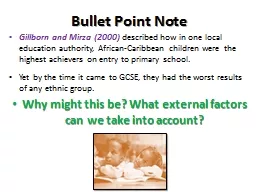PPT-Bullet Point Note Gillborn and
Author : kittie-lecroy | Published Date : 2018-10-30
Mirza 2000 described how in one local education authority AfricanCaribbean children were the highest achievers on entry to primary school Yet by the time it came
Presentation Embed Code
Download Presentation
Download Presentation The PPT/PDF document "Bullet Point Note Gillborn and" is the property of its rightful owner. Permission is granted to download and print the materials on this website for personal, non-commercial use only, and to display it on your personal computer provided you do not modify the materials and that you retain all copyright notices contained in the materials. By downloading content from our website, you accept the terms of this agreement.
Bullet Point Note Gillborn and: Transcript
Download Rules Of Document
"Bullet Point Note Gillborn and"The content belongs to its owner. You may download and print it for personal use, without modification, and keep all copyright notices. By downloading, you agree to these terms.
Related Documents














